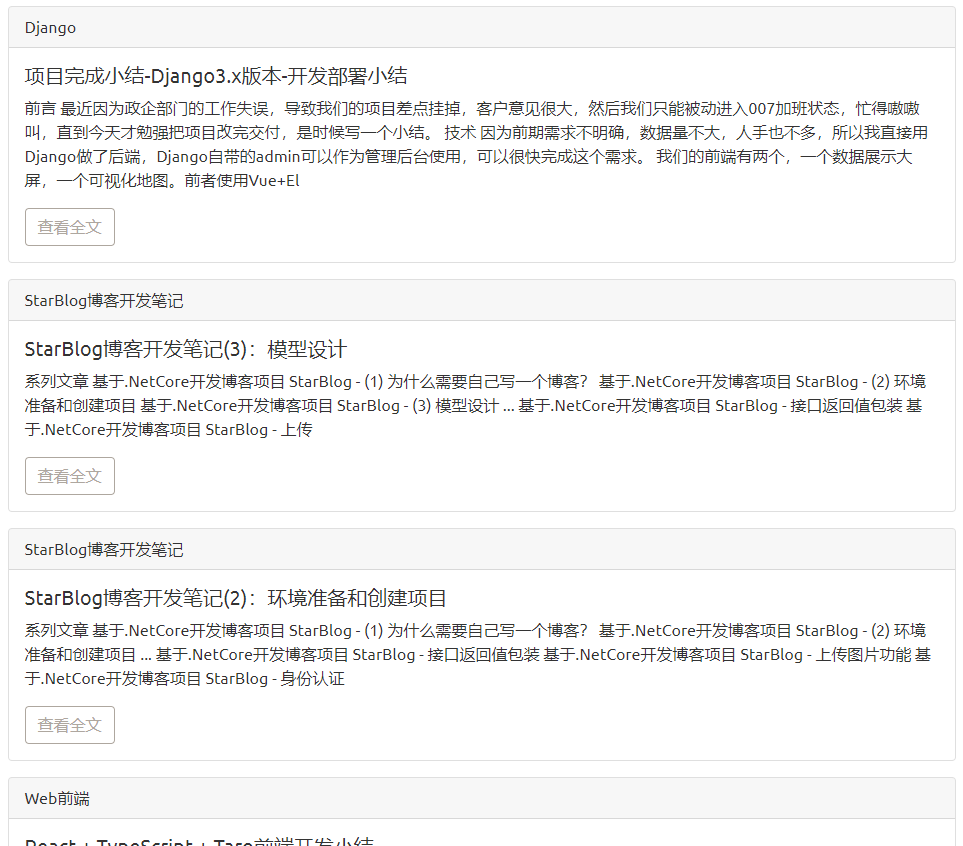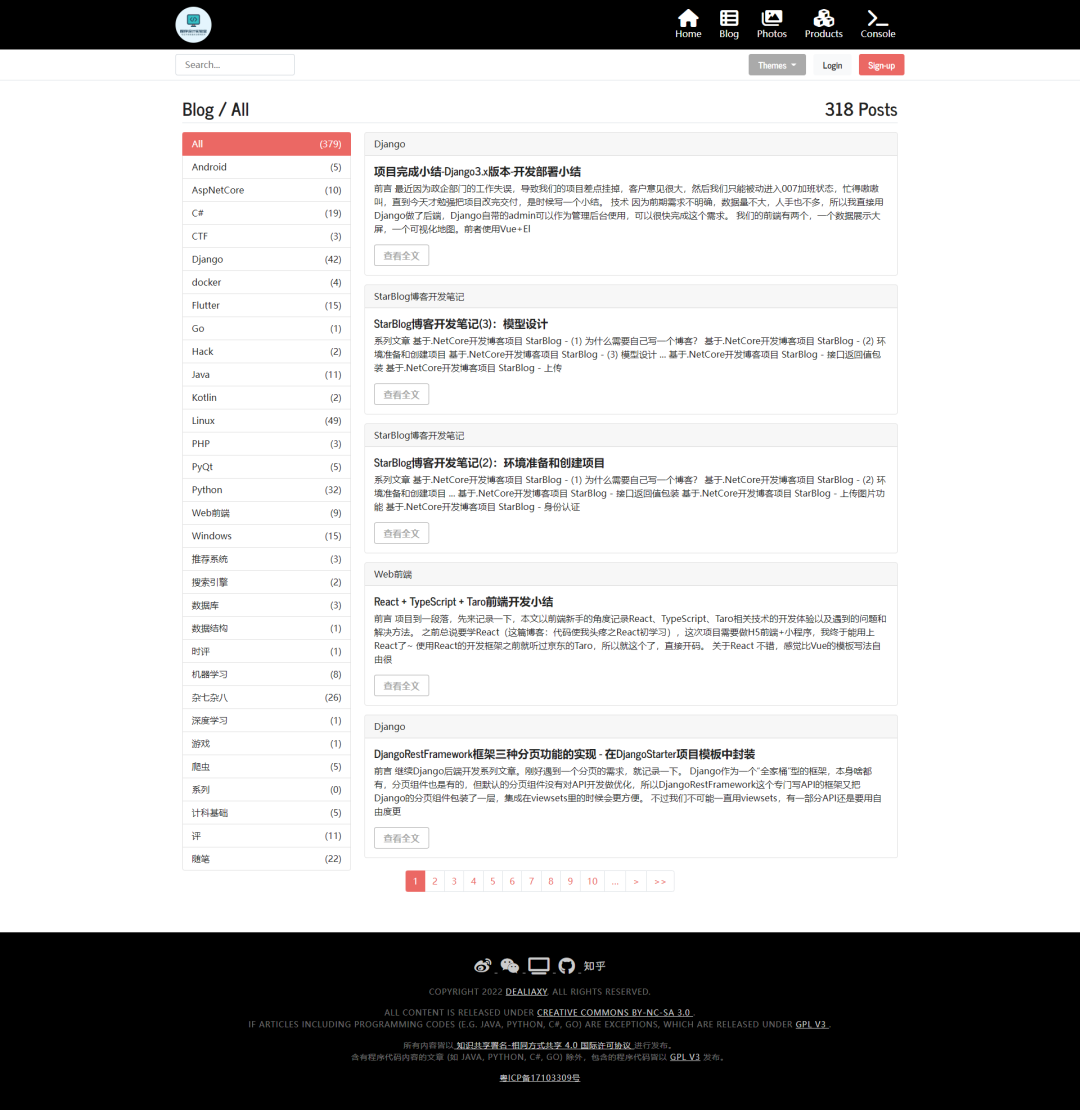系列文章
基于.NetCore开发博客项目 StarBlog - (1) 为什么需要自己写一个博客?
基于.NetCore开发博客项目 StarBlog - (2) 环境准备和创建项目
基于.NetCore开发博客项目 StarBlog - (3) 模型设计
基于.NetCore开发博客项目 StarBlog - (4) markdown博客批量导入
基于.NetCore开发博客项目 StarBlog - (5) 开始搭建Web项目
基于.NetCore开发博客项目 StarBlog - (6) 页面开发之博客文章列表
...
前言
前一篇文章把Web项目搭起来了,现在开始来写页面~
本文记录博客文章列表的开发,包括参数、分类过滤、分页、搜索、排序等内容。
ORM
本项目的ORM使用FreeSQL,前面「博客批量导入」的文章中有初步涉及到了,不过没有介绍太多,这里再讲一下几个关键的地方。
不同于网上比较常见的EF Core,FreeSQL设计完模型之后不需要进行迁移操作,在开发模式下开启自动结构同步(AutoSyncStructure)就能自动创建、修改数据表。
还有比较方便的一点是FreeSQL自带了简单的仓储模式,不用再自己封装一套,可以减少开发时的代码量~
不过局限性也是有的,不封装仓储层的话,意味着service层代码跟ORM绑定,以后如果切换ORM会带来额外的重构成本。
打开StarBlog.Data项目,我们来写一个扩展方法,新增Extensions目录,在里面新增ConfigureFreeSql.cs
using FreeSql;
using Microsoft.Extensions.Configuration;
using Microsoft.Extensions.DependencyInjection;namespace StarBlog.Data.Extensions;public static class ConfigureFreeSql {public static void AddFreeSql(this IServiceCollection services, IConfiguration configuration) {var freeSql = new FreeSqlBuilder().UseConnectionString(DataType.Sqlite, configuration.GetConnectionString("SQLite")).UseAutoSyncStructure(true).Build();services.AddSingleton(freeSql);// 仓储模式支持services.AddFreeRepository();}
}然后编辑StarBlog.Web项目下的Program.cs,注册一下FreeSQL的服务,用我们刚才写的扩展方法。
using StarBlog.Data.Extensions;builder.Services.AddFreeSql(builder.Configuration);在要用的地方注入就行了,比如
IBaseRepository<Post> _postRepo;// 获取全部文章
_postRepo.Select.ToList()就很方便了,开箱即用~
Service
因为我们的后端既要渲染页面,又要做RESTFul接口,所以要把业务逻辑抽象出来放在service层,避免在Controller里重复。
在StarBlog.Web项目的Services目录里新增PostService.cs,我们要在这封装跟文章有关的逻辑~
首先依赖注入,把需要用到的服务注入进来
public class PostService {private readonly IBaseRepository<Post> _postRepo;private readonly IBaseRepository<Category> _categoryRepo;public PostService(IBaseRepository<Post> postRepo,IBaseRepository<Category> categoryRepo) {_postRepo = postRepo;_categoryRepo = categoryRepo;}
}写一个获取全部文章的方法
public List<Post> GetAll() {return _postRepo.Select.ToList();
}这样就初步搞定了,接下来要来写Controller
Controller
在StarBlog.Web项目的Controllers目录下,新增BlogController.cs,用来实现跟博客有关的接口。
注入刚刚写好的 PostService
public class BlogController : Controller {private readonly PostService _postService;public BlogController(PostService postService) {_postService = postService;}
}写文章列表“接口”(MVC也算接口吧)
public IActionResult List() {return View(_postService.GetAll());
}View
根据AspNetCore MVC项目的约定,要把网页模板放在Views目录下,按Controller分类
这个文章列表页面,按照约定的路径是:Views/Blog/List.cshtml,创建这个文件
@model List<Post>
@{ViewData["Title"] = "博客列表";
}
<div class="container px-4 py-3">@foreach (var post in Model) {<div class="card mb-3"><div class="card-header">@Model.Category.Name</div><div class="card-body"><h5 class="card-title">@Model.Title</h5><p class="card-text">@Model.Summary</p><a class="btn btn-outline-secondary stretched-link"asp-controller="Blog" asp-action="Post" asp-route-id="@Model.Id">查看全文</a></div></div>}
</div>这样简单的文章列表就完成了
试试效果
运行项目,打开浏览器,输入地址http://127.0.0.1:5038/Blog/List,可以看到文章列表如下,很简单(简陋),而且全部文章都显示出来了,页面很长,这很明显并不是我们想要的最终效果。

不急,接下来慢慢来优化。
分页
首先是页面把全部文章都显示出来的问题,我们需要引入分页功能
分页可以自己实现,也可以用第三方组件,我们用的FreeSQL也支持分页的API,这里我直接掏出之前做项目用过的X.PagedList,它封装了分页取数据和前端的分页部件,比较方便。
直接nuget里安装这两个包就行:
X.PagedList
X.PagedList.Mvc.Core
使用很简单,X.PagedList组件定义了List类型的扩展方法,直接在ORM读取出来的List上用就行
_postRepo.Select.ToList().ToPagedList(pageNumber, pageSize);返回类型是IPagedList<T>,除了当前页面的数据,还包含有分页的信息(当前页面、总页面数量、页面大小、总数据量等),可以直接当List用。
然后X.PagedList组件还封装了MVC模板上的HTML组件,使用也很简单:
<nav aria-label="Page navigation example">@Html.PagedListPager(Model.Posts, page => Url.Action(RazorHelper.GetCurrentActionName(ViewContext), new {page, categoryId = Model.CurrentCategoryId}),new PagedListRenderOptions {LiElementClasses = new[] {"page-item"},PageClasses = new[] {"page-link"},UlElementClasses = new[] {"pagination justify-content-center"}})
</nav>前端我要使用bootstrap的分页组件,所以把bootstrap的class传进去,如果是其他前端组件库的话,只需要传对应的class名称就行。
渲染出来的页面代码是这样的:
<div class="pagination-container"><ul class="pagination justify-content-center"><li class="active page-item"><span class="page-link">1</span></li><li class="page-item"><a class="page-link" href="/Blog/List?page=2&categoryId=0">2</a></li><li class="page-item"><a class="page-link" href="/Blog/List?page=3&categoryId=0">3</a></li><li class="page-item"><a class="page-link" href="/Blog/List?page=4&categoryId=0">4</a></li><li class="page-item"><a class="page-link" href="/Blog/List?page=5&categoryId=0">5</a></li><li class="page-item"><a class="page-link" href="/Blog/List?page=6&categoryId=0">6</a></li><li class="page-item"><a class="page-link" href="/Blog/List?page=7&categoryId=0">7</a></li><li class="page-item"><a class="page-link" href="/Blog/List?page=8&categoryId=0">8</a></li><li class="page-item"><a class="page-link" href="/Blog/List?page=9&categoryId=0">9</a></li><li class="page-item"><a class="page-link" href="/Blog/List?page=10&categoryId=0">10</a></li><li class="PagedList-ellipses page-item"><a class="PagedList-skipToNext page-link" href="/Blog/List?page=11&categoryId=0" rel="next">…</a></li><li class="PagedList-skipToNext page-item"><a class="page-link" href="/Blog/List?page=2&categoryId=0" rel="next">></a></li><li class="PagedList-skipToLast page-item"><a class="page-link" href="/Blog/List?page=64&categoryId=0">>></a></li></ul>
</div>显示效果:

请求参数封装
前面介绍的分页需要在访问页面时传入请求参数,这样我们Controller的Action方法就需要加上pageNumber和pageSize这两个参数,后面还要加文章分类筛选和搜索排序什么的,这样参数太多了,全都写在Action方法的参数里不优雅,好在AspNetCore提供了class作为参数的写法。
在StarBlog.Web/ViewModels目录下新建QueryFilters目录,用来存不同接口的请求参数。
有些参数属于不同接口都有的,合理利用面向对象,先写个基类:QueryParameters.cs
public class QueryParameters {/// <summary>/// 最大页面条目/// </summary>public const int MaxPageSize = 50;private int _pageSize = 10;/// <summary>/// 页面大小/// </summary>public int PageSize {get => _pageSize;set => _pageSize = (value > MaxPageSize) ? MaxPageSize : value;}/// <summary>/// 当前页码/// </summary>public int Page { get; set; } = 1;/// <summary>/// 搜索关键词/// </summary>public string? Search { get; set; }/// <summary>/// 排序字段/// </summary>public string? SortBy { get; set; }
}文章请求参数在此基础上还增加了状态、分类等,从上面这个基类派生一个新类就好:PostQueryParameters.cs
public class PostQueryParameters : QueryParameters {/// <summary>/// 仅请求已发布文章/// </summary>public bool OnlyPublished { get; set; } = false;/// <summary>/// 文章状态/// </summary>public string? Status { get; set; }/// <summary>/// 分类ID/// </summary>public int CategoryId { get; set; } = 0;/// <summary>/// 排序字段/// </summary>public new string? SortBy { get; set; } = "-LastUpdateTime";
}service改造
我们的核心逻辑都是在service中实现的,请求参数肯定也要传入给service来使用。
依然是先前的GetPagedList方法,给其加上各种筛选条件之后是这样:
public IPagedList<Post> GetPagedList(PostQueryParameters param) {var querySet = _postRepo.Select;// 是否发布if (param.OnlyPublished) {querySet = _postRepo.Select.Where(a => a.IsPublish);}// 状态过滤if (!string.IsNullOrEmpty(param.Status)) {querySet = querySet.Where(a => a.Status == param.Status);}// 分类过滤if (param.CategoryId != 0) {querySet = querySet.Where(a => a.CategoryId == param.CategoryId);}// 关键词过滤if (!string.IsNullOrEmpty(param.Search)) {querySet = querySet.Where(a => a.Title.Contains(param.Search));}// 排序if (!string.IsNullOrEmpty(param.SortBy)) {// 是否升序var isAscending = !param.SortBy.StartsWith("-");var orderByProperty = param.SortBy.Trim('-');querySet = querySet.OrderByPropertyName(orderByProperty, isAscending);}return querySet.Include(a => a.Category).ToList().ToPagedList(param.Page, param.PageSize);
}根据传入的参数,可以实现状态过滤、分类过滤、关键词过滤、排序和分页功能。
ViewModel
一个MVC页面只能指定一个Model,虽然可以用弱类型的ViewBag或者ViewData,但是弱类型不好维护,我们来定义一个ViewModel给页面使用。
先确定要在文章列表页面显示哪些内容,例如显示当前选择的文章分类、所有分类列表。
在StarBlog.Web的ViewModels目录下,新建BlogListViewModel.cs,根据我们要展示的内容,定义模型如下
using StarBlog.Data.Models;
using X.PagedList;namespace StarBlog.Web.ViewModels; public class BlogListViewModel {public Category CurrentCategory { get; set; }public int CurrentCategoryId { get; set; }public IPagedList<Post> Posts { get; set; }public List<Category> Categories { get; set; }
}搞定。
controller改造
经过前面的铺垫,controller这里就简单了,不过还有要注意的地方,本项目是包含后端渲染和RESTFul接口两部分的,因此controller要写两个,service只要一个就行。
RESTFul接口我后面再具体介绍,可以先看看改造后的RESTFul接口controller的代码:
[AllowAnonymous]
[HttpGet]
public ApiResponsePaged<Post> GetList([FromQuery] PostQueryParameters param) {var pagedList = _postService.GetPagedList(param);return new ApiResponsePaged<Post> {Message = "Get posts list",Data = pagedList.ToList(),Pagination = pagedList.ToPaginationMetadata()};
}代码很简单,这个获取文章列表的接口,就单纯只需要给分页和过滤后的列表数据就行。
而MVC的接口就没这么简单,要显示在页面上的东西,全都要在后端做渲染,包括我们在前面说的要显示当前分类、所有分类列表。
代码长这样:
public IActionResult List(int categoryId = 0, int page = 1, int pageSize = 5) {var categories = _categoryRepo.Where(a => a.Visible).IncludeMany(a => a.Posts).ToList();categories.Insert(0, new Category { Id = 0, Name = "All", Posts = _postRepo.Select.ToList() });return View(new BlogListViewModel {CurrentCategory = categoryId == 0 ? categories[0] : categories.First(a => a.Id == categoryId),CurrentCategoryId = categoryId,Categories = categories,Posts = _postService.GetPagedList(new PostQueryParameters {CategoryId = categoryId,Page = page,PageSize = pageSize,OnlyPublished = true})});
}传入参数只需要三个:
分类ID
当前页面
页面大小
这个接口要做的事比较多
获取所有分类
判断当前分类
获取文章列表
最终返回我们前面定义的BlogListViewModel
然后在页面模板里就可以用了。
View改造
第一件事把model换成BlogListViewModel
然后就是根据ViewModel里的数据进行页面渲染,都是Bootstrap提供的页面组件,代码比较长我就不贴了,页面模板的完整代码可以在这看到:https://github.com/Deali-Axy/StarBlog/blob/master/StarBlog.Web/Views/Blog/List.cshtml
最终效果
截了个长图,最终的页面效果就是这样了~

小结
如果你看到了这里,说明你是个有耐心的人 O(∩_∩)O哈哈~,同时对本项目是比较感兴趣的,先感谢大家的支持~
本文一不小心就写得比较长了,本来是想以那种每篇文章比较短的形式做一个连载,这样读起来不会有太大的压力,没想到稍微一展开讲就涉及到很多内容,接下来的文章我得优化优化~
最近一段时间,公众号后台、微信都有收到朋友的催更,或者是抱怨我更新得太慢,实在是抱歉,最近被工作上的事情搞得有点晕头转向的,下班回家后晚上就只想看会书或者玩一下游戏放松,懈怠了,看到有这么多大佬在关注我的项目,顿时又充满动力了!冲冲冲,接下来争取每两天更新一篇,欢迎继续关注 ~
~



循环有多容易?你看一眼就怀...)







(9*9 乘法表)寻找电脑中的盲盒彩蛋)





加载Python神器!亮剑!)
【python】)
